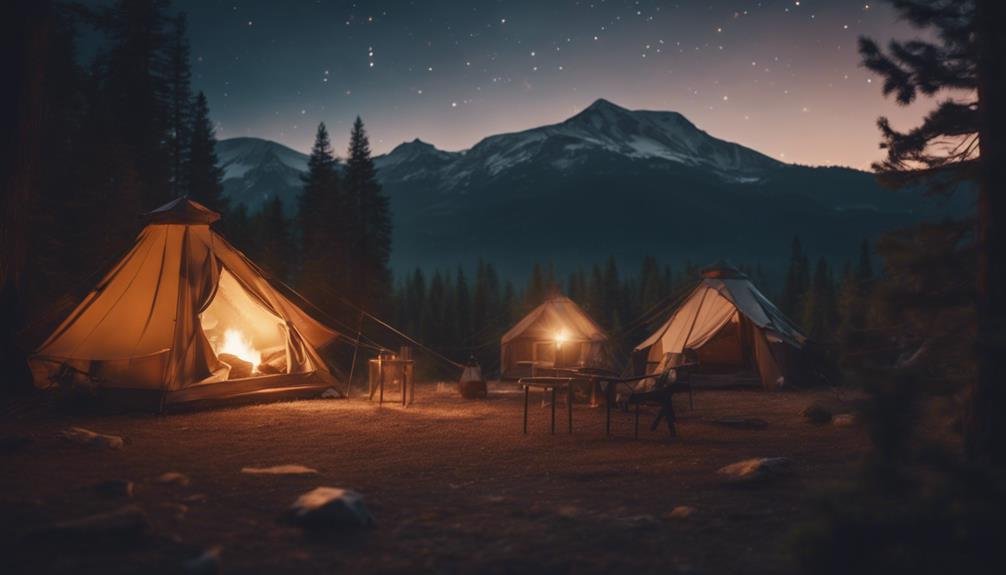
Choosing the perfect camping tent is all about comfort and protection. I make sure to consider the tent's size, weight, and weather resistance. I prefer lightweight materials that pack easily, yet still offer durability. For those humid nights, I always look for good ventilation to keep condensation at bay. I also pay attention to extra features like storage pockets and vestibules for my gear. Budgeting is key; I stick to what I need while eyeing essential upgrades. With the right tent, I feel at home in the wild, ready for my next great adventure. There's so much more to explore!
Key Takeaways
- Determine the tent size based on the number of campers and gear, opting for slightly larger to ensure comfort.
- Choose weather-resistant materials with waterproof ratings and sealed seams to protect against rain and moisture.
- Prioritize ventilation features, such as mesh panels and adjustable vents, to prevent condensation and maintain air circulation.
- Consider weight and packability for easy transport, especially if backpacking, aiming for a packed weight under 5 pounds.
Types of Camping Tents
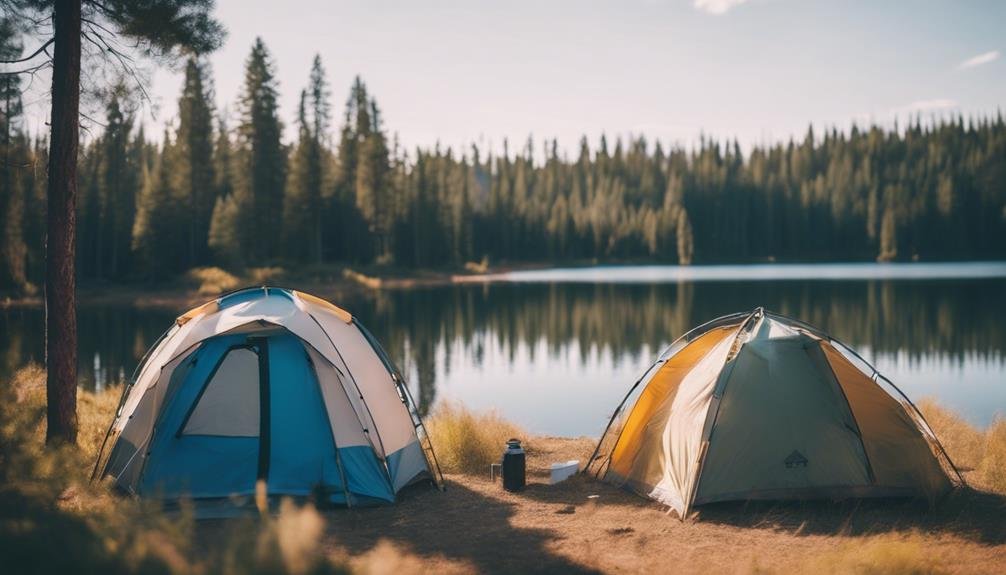
When it comes to camping tents, understanding the different types available can make all the difference in ensuring a comfortable and enjoyable outdoor experience. I've explored various options, and I've found that the choice often boils down to tent materials and ventilation requirements.
For instance, if I'm heading into a damp environment, I prefer a tent made from polyester or nylon, as these materials resist moisture and dry quickly. On the other hand, cotton canvas tents offer excellent breathability, making them great for warmer climates, but they can be heavier to carry.
When selecting a tent, I never overlook ventilation. A good tent needs adequate airflow to prevent condensation buildup, which can ruin my night's sleep. Mesh panels and adjustable vents are features I always look for, especially on warmer nights when I want to enjoy the fresh air without letting in pests.
Ultimately, the right type of tent aligns with my camping style and the environment I'm venturing into. By considering tent materials and ventilation, I ensure my camping experience is as carefree and enjoyable as possible.
Size Considerations
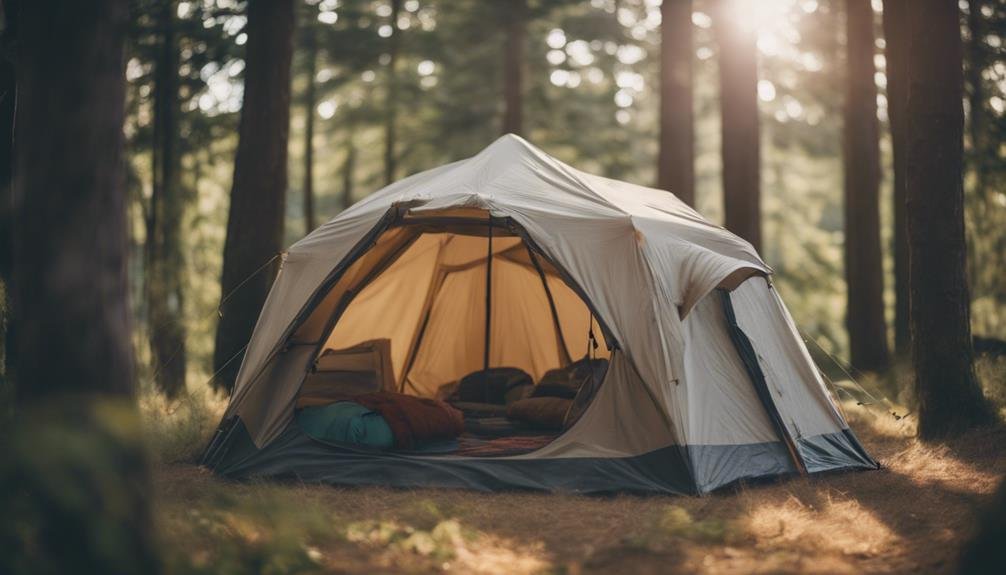
When choosing a camping tent, I always think about how many people will be sleeping in it and the space we'll need for our gear.
It's essential to find a balance between comfort and practicality, so everyone has enough room to move around.
Let's explore how tent capacity and gear space can make or break your camping experience.
Tent Capacity Requirements
Selecting the right tent capacity is crucial for ensuring comfort and a pleasant camping experience, as it directly influences how much space I'll have for sleeping, gear, and movement. When I choose my tent, I consider how many people will be using it and their floor space needs. A tent that feels cramped can quickly turn a relaxing getaway into a frustrating ordeal.
A well-ventilated tent helps prevent condensation and keeps the air fresh, which is essential for a good night's sleep. If I'm camping in warmer weather, having extra space can make a big difference in airflow.
If I'm camping with friends, I'll factor in not just sleeping space but also room for gear and personal items. I've learned that a tent labeled for four people might be a tight squeeze, especially if we're sharing gear. Instead, I often opt for a tent that accommodates one or two more than the number of campers. This way, I can enjoy a more spacious, comfortable environment that enhances my outdoor experience.
Space for Gear
Finding enough space for my gear is just as important as ensuring there's room for sleeping, especially since I want my camping experience to be organized and stress-free. When I choose a tent, I make sure it offers ample storage space for my equipment. I've learned that a tent with vestibules or pockets can provide excellent storage solutions for smaller items like shoes, bags, or cooking gear, keeping everything accessible yet out of the way.
I also consider the overall layout of the tent. A higher peak height allows me to move around without bumping into things and helps me keep my gear neatly arranged. If I'm camping with friends or family, I need to think about how much gear everyone will bring. That's why I often opt for a tent that can comfortably accommodate more than just our sleeping bags.
Additionally, I always scout for tents with external attachment points for gear lofts or hooks for lanterns. This way, I can maximize my space and keep my campsite tidy. Ultimately, efficient storage solutions can transform my camping adventures from chaotic to enjoyable, allowing me to focus on what matters most—embracing the great outdoors.
Weather Resistance
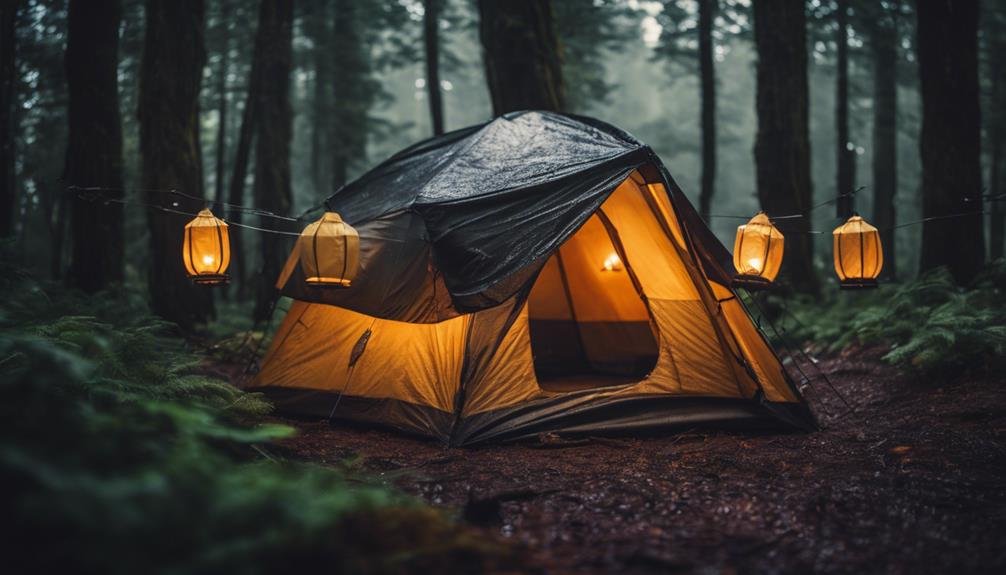
A tent's weather resistance is crucial because it can mean the difference between a comfortable night under the stars and a soggy, miserable experience. When I'm out in nature, I want to know my tent can handle whatever Mother Nature throws at it.
To ensure I stay dry and comfy, I look for these key features:
- Waterproof materials: A good tent should have a high waterproof rating to keep rain out.
Breathability: Proper ventilation helps with condensation management, ensuring the inside stays dry and comfortable.
Strong zippers: They should seal tightly to keep water out while allowing easy access.
Good design: Tents with a sloped roof minimize water pooling.
Weight and Portability

When I'm gearing up for a camping trip, the weight and portability of my tent are top priorities, as I want something that's easy to carry without sacrificing comfort. I've learned that a tent's packed weight is crucial; if it's too heavy, it becomes a burden on my back during those long hikes. Ideally, I look for tents that weigh under five pounds, which typically balances durability and livability.
Another key factor is the pack size. I prefer tents that can fit snugly into my backpack without taking up too much space. A compact design allows me to bring along other essentials, like sleeping gear or cooking supplies. Tents with a smaller pack size are usually more convenient, especially when I'm navigating tricky terrains or exploring off the beaten path.
I also consider the materials used; lightweight fabrics can significantly reduce packed weight while maintaining strength. When I find the right combination of pack size and packed weight, I feel more at ease knowing I can enjoy my adventure without the hassle of an unwieldy tent. Choosing wisely here means freedom to roam and explore!
Setup and Take Down

Setting up and taking down my tent efficiently can make or break my camping experience, so I always look for designs that offer quick and straightforward assembly. A smooth tent assembly process allows me to spend more time enjoying nature rather than wrestling with poles and fabric.
I've learned a few essential tent folding techniques that help me pack up quickly and minimize hassle.
Practice at home: Familiarize myself with the tent assembly process before hitting the road.
Organize parts: Keep poles, stakes, and rainfly in separate bags for easy access.
Follow the instructions: Read the manual to avoid the guesswork during setup.
Use a ground tarp: It protects the tent floor and makes packing up easier.
Stay calm and patient: If things go wrong, taking a breath helps me focus and solve the issue.
Features to Look For

When I'm choosing a camping tent, I always focus on size and capacity first. It's crucial to ensure everyone has enough space to sleep comfortably, especially on longer trips.
Plus, I can't overlook weather resistance features because staying dry and protected from the elements is a must for any adventure.
Size and Capacity
Choosing the right size and capacity for your camping tent is essential to ensure comfort and functionality during your outdoor adventures. Understanding the tent dimensions and how they relate to your sleeping configuration can make or break your camping experience.
- Occupancy: How many people will sleep in the tent?
- Sleeping Configuration: Are you using sleeping bags, air mattresses, or cots?
- Gear Storage: Will you need extra space for your gear, like backpacks or cooking supplies?
- Headroom: Do you want to sit up comfortably, or can you manage with a low ceiling?
Weather Resistance Features
As I explore the world of camping tents, I always prioritize weather resistance features to ensure I stay dry and comfortable, no matter what Mother Nature throws my way. First and foremost, I look for tents with excellent waterproofing. A rainfly with a high waterproof rating, ideally above 3000mm, is essential. This way, I can confidently face unexpected downpours without worrying about leaks.
Next, I consider the tent's materials. A durable, water-resistant fabric is crucial, but I also want to ensure it has good breathability. This balance prevents condensation from building up inside the tent, keeping the air fresh and comfortable. Mesh panels are a great feature that allows for airflow while keeping bugs at bay.
Another aspect I pay attention to is the tent's seams. Taped seams are a must, as they provide an extra layer of protection against water seepage. Additionally, I prefer tents with a sturdy, waterproof floor to shield me from moisture rising from the ground.
Budgeting for Your Tent
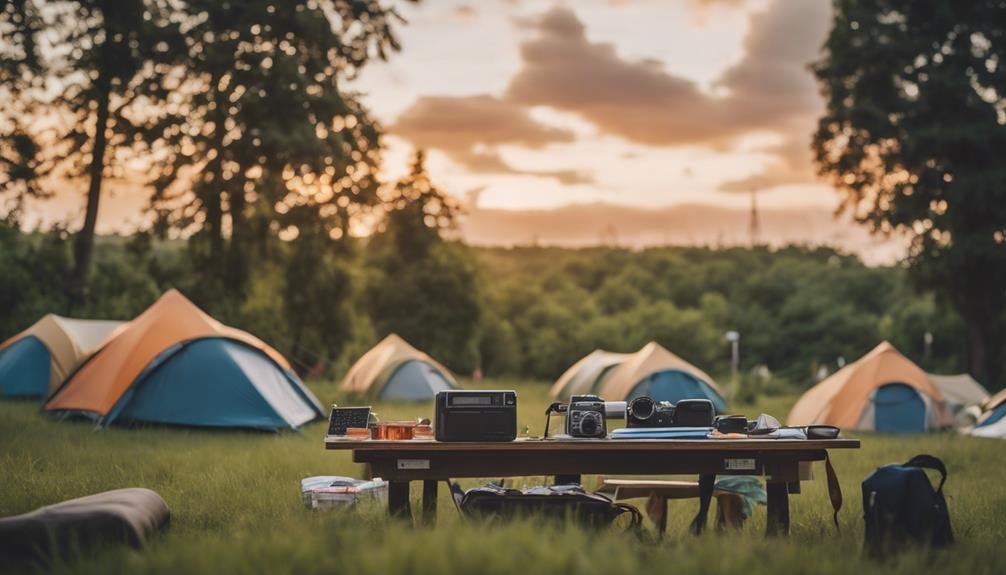
Budgeting for a camping tent means balancing quality and cost to ensure I get the best value for my outdoor adventures. I want a tent that can withstand the elements while also fitting my budget.
Set a clear budget: Determine how much I'm willing to spend before I start shopping.
Research features: Identify which features are essential for my needs (e.g., size, weight, weather resistance).
Consider upgrades: Look into budgeting for tent upgrades that enhance durability or comfort without breaking the bank.
Evaluate rental options: If I'm not ready to commit, evaluating tent rental options can be a cost-effective way to enjoy camping without a hefty upfront investment.
Read reviews: Hearing from fellow campers can guide me towards the best value tents that balance cost and performance.
Tent Accessories
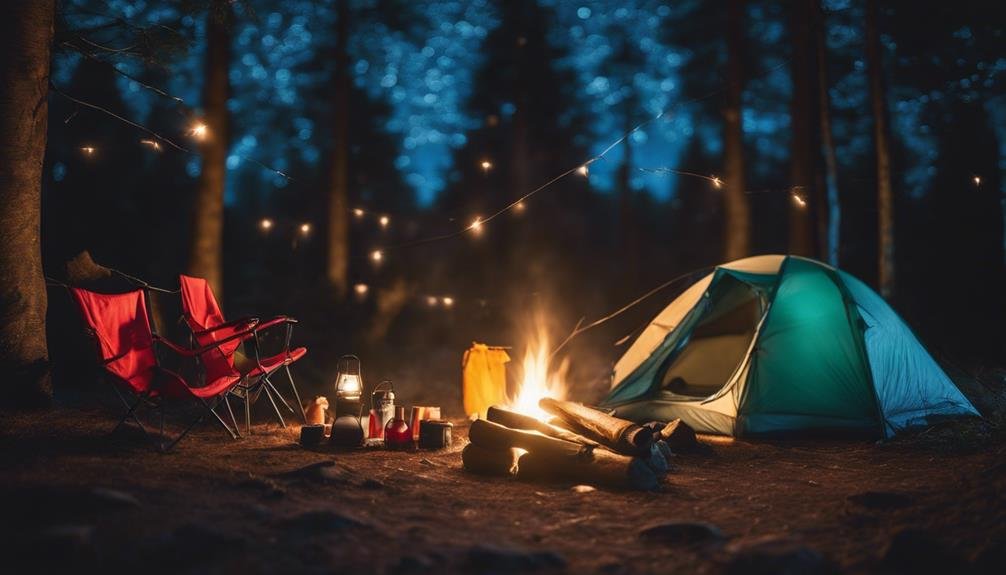
Once I've settled on a budget for my tent, the next step is to explore the accessories that can enhance my camping experience. First up are lighting options. I love using LED lanterns or string lights to create a cozy atmosphere inside my tent. They're lightweight and often come with multiple brightness settings, allowing me to set the mood or keep things bright enough for reading.
Next, I can't overlook ventilation systems. Proper airflow is crucial, especially during warm nights. I usually look for tents that come with built-in vents or mesh panels. This keeps fresh air flowing while minimizing condensation. If my tent lacks these features, I sometimes add a portable fan, which can work wonders in keeping the air circulating.
I also consider storage solutions, like hanging organizers or gear lofts, to keep my essentials easily accessible.
Maintenance Tips
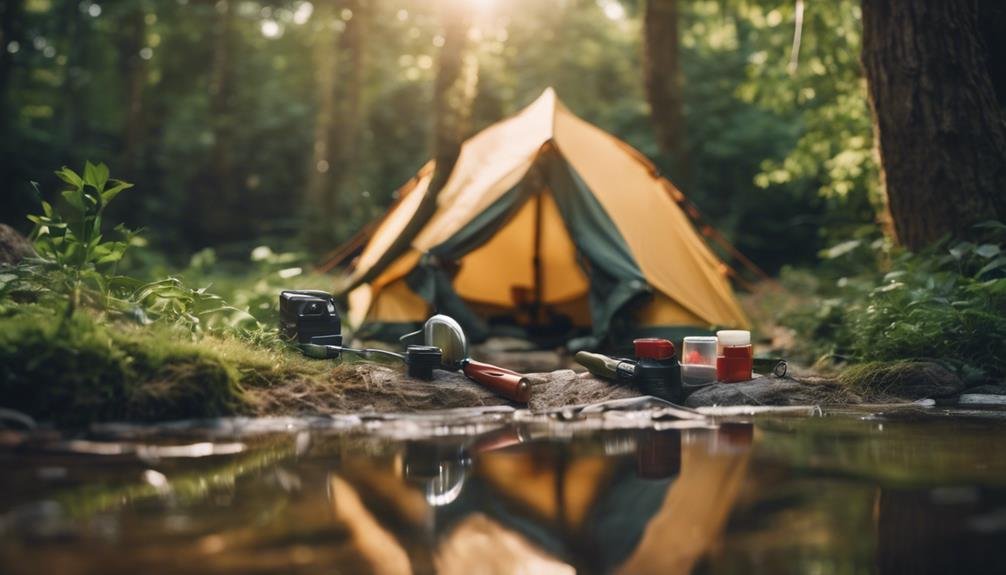
Maintaining my camping tent is essential for ensuring its longevity and performance during my outdoor adventures. A well-cared-for tent not only enhances my experiences but also keeps me comfortable, no matter where I pitch it.
I always shake off dirt and debris, then wash it with mild soap and water.
Before storing, I make sure the tent is completely dry to prevent mold and mildew.
I avoid compressing my tent in a stuff sack; instead, I store it loosely in a cool, dry place.
I check for any damage, such as tears or broken zippers, and repair them promptly to protect my tent.
When camping, I always lay down a footprint to protect the tent floor from abrasions.
Popular Brands and Models
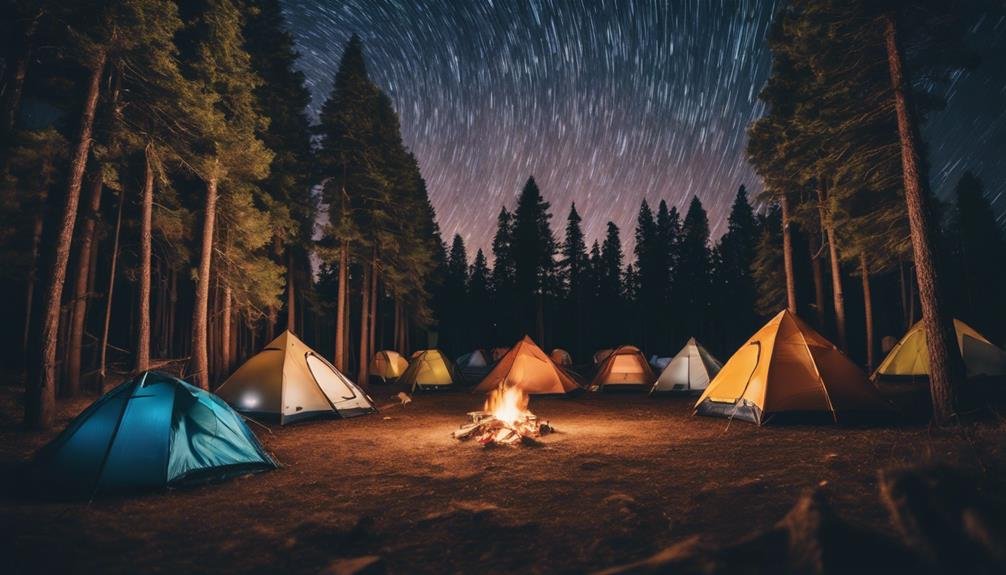
After ensuring my tent is well-maintained, I often explore the various popular brands and models available to find the best fit for my camping needs. With so many options out there, I've learned a few key brands that consistently deliver on tent fabric quality and insulation options. Here's a quick overview of some top contenders that I like to consider:
| Brand | Key Features | Ideal For |
|---|---|---|
| Coleman | Affordable, durable fabric | Family camping |
| Big Agnes | Lightweight, excellent insulation | Backpackers |
| REI Co-op | High-quality materials, eco-friendly | Outdoor enthusiasts |
| MSR | Strong weather resistance | Extreme conditions |
| Sierra Designs | Versatile designs with good airflow | All-season camping |
Each brand offers unique models tailored to different camping styles. I look for tents that provide excellent tent fabric quality to withstand the elements, while also considering insulation options for those chilly nights. By comparing these brands, I can confidently choose a tent that aligns with my adventurous spirit. Happy camping!
Conclusion
Choosing the perfect camping tent can truly enhance your outdoor experience. Did you know that over 40% of campers say a good tent significantly improves their enjoyment of nature?
By considering the types, size, weather resistance, and portability, I can find a tent that feels like a home away from home. With the right accessories and maintenance, my camping adventures can be comfortable and memorable.
So, let's gear up and get ready to explore the great outdoors!
